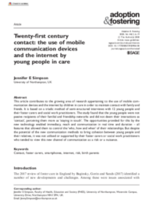Abstract
This article contributes to the growing area of research appertaining to the use of mobile communication devices and the internet by children in care in order to maintain contact with family and friends. It is based on a triadic method of semi-structured interviews with 12 young people and their foster carers and social work practitioners. The study found that the young people were not passive recipients of their familial and friendship networks and did not deem their interactions as ‘contact’, perceiving them more as ‘staying in touch’. The opportunities provided for this by the new technology enabled immediacy, reach and communication in real time and duration – all features that allowed them to control the ‘who, how and when’ of their relationships. But despite the potential of the new communication methods to bring cohesion between young people and their relatives, it was not utilised or supported by their foster carers or social work practitioners who tended to view this new channel of communication as a risk or a nuisance.

